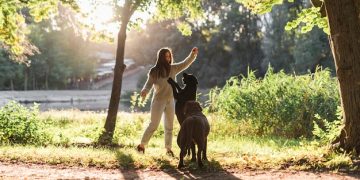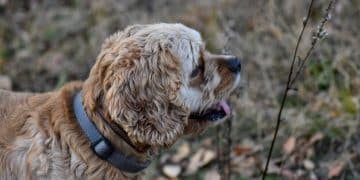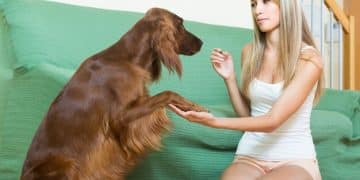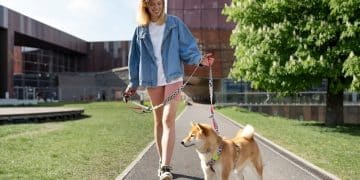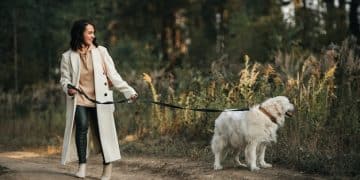Train Your Dog to Walk Nicely: A Step-by-Step Guide
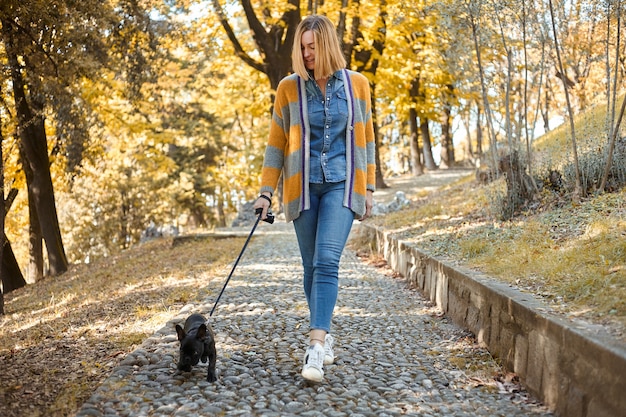
Anúncios
Train your dog to walk nicely on a leash involves teaching them to walk calmly by your side without pulling, creating a more enjoyable experience for both you and your furry friend through consistent training and positive reinforcement.
Does your dog pull on the leash, turning your walks into a frustrating tug-of-war? Train your dog to walk nicely on a leash with our step-by-step guide, transforming your strolls into enjoyable experiences.
Anúncios
Why Loose-Leash Walking Matters
Walking your dog should be a pleasant experience for both of you. However, a dog that pulls on the leash can make walks stressful and even dangerous. Let’s explore why train your dog to walk nicely on a leash is not just a matter of convenience, but also of safety and wellbeing.
Loose-leash walking offers numerous benefits, enhancing the bond between you and your canine companion while promoting better physical and mental health. Consistency in training and positive reinforcement goes a long way.
Anúncios
Physical Health Benefits
Pulling on the leash can strain your dog’s neck and back, leading to discomfort and potential injuries. With proper training, your dog learns to walk in a more natural and balanced posture.
Mental Health Benefits
A relaxed walk allows your dog to explore their surroundings without the anxiety of being constantly corrected. This mental stimulation is crucial for their overall wellbeing.
- Improved Safety: Loose-leash walking reduces the risk of accidents caused by sudden lunges or pulls.
- Enhanced Enjoyment: Walks become more enjoyable for both you and your dog when the leash is slack.
- Stronger Bond: Training together strengthens the bond between you and your furry friend.
Effective loose-leash walking involves clear communication and consistent reinforcement. Using positive reinforcement techniques encourages the desired behavior, and makes the training experience more rewarding.
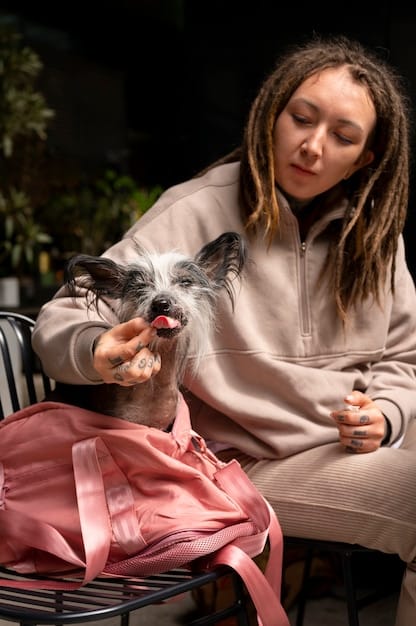
In summary, teaching your dog to walk nicely on a leash is an investment in their physical and mental health, as well as your own enjoyment. It creates a safer and more pleasant experience for both of you.
Essential Equipment for Training
Before you start training your dog to walk nicely on a leash, it’s important to have the right equipment. The appropriate gear can make the training process smoother and more effective. Let’s explore the essential equipment that can aid your journey.
Choosing the right equipment ensures both your comfort and your dog’s safety. The right equipment can also enhance communication and reinforce positive behaviours.
Leash Options
A standard 4-6 foot leash is ideal for training. Avoid retractable leashes, as they can encourage pulling and offer less control.
Harness vs. Collar
A front-clip harness can be a great tool for preventing pulling, as it redirects your dog’s attention when they try to lunge forward. Alternatively, a well-fitted collar is suitable for dogs that respond well to gentle guidance.
- Treat Pouch: A treat pouch keeps rewards readily accessible for positive reinforcement.
- High-Value Treats: Small, soft treats that your dog loves are essential for capturing their attention and motivating them.
- Comfortable Walking Shoes: Don’t forget to take care of yourself! Comfortable shoes will make the training process more enjoyable for you.
Consistency in your commands and positive reinforcement using treats can help your dog associate the desired behavior with positive outcomes.
Selecting the right equipment is crucial for successful loose-leash walking training. With the right gear, you can effectively communicate with your dog and reinforce positive behaviors.
Step-by-Step Training Techniques
Now that you have the right equipment, it’s time to dive into the training techniques. Consistency and patience are key to train your dog to walk nicely on a leash. Let’s break down the process into manageable steps, that ensure a positive outcome.
These techniques involve clear communication, positive reinforcement, and consistent practice. Regular short training sessions are more effective than long, infrequent ones.
Start Indoors
Begin by practicing loose-leash walking indoors. This helps your dog get used to the equipment and the concept of walking without pulling in a familiar environment.
The “Stop and Wait” Method
If your dog starts to pull, stop walking immediately. Wait for your dog to stop pulling and give you attention before continuing. This teaches them that pulling will not get them anywhere.
- Change Direction: If your dog starts to pull, change direction. This forces them to pay attention to you and walk at your pace.
- Reward Good Behavior: When your dog walks nicely beside you with a loose leash, reward them with praise and treats.
- Keep Sessions Short: Aim for 10-15 minute training sessions to keep your dog engaged and prevent frustration.
Consistency is key. Every time your dog pulls, repeat the “stop and wait” method. The consistent application of these principles will help your dog learn the appropriate behavior quickly.
By following these step-by-step training techniques, you can effectively teach your dog to walk nicely on a leash. Patience and consistency are your best allies in this process.
Common Mistakes to Avoid
Even with the best intentions, it’s easy to make mistakes when training your dog to walk nicely on a leash. Recognizing and avoiding these pitfalls can significantly improve your training progress. Let’s identify some common errors preventing success.
Being aware of these common mistakes will help you refine your approach and achieve better results. Adjustments to your training style can make a significant difference.
Using Retractable Leashes
Retractable leashes can encourage pulling, as they allow your dog to wander far ahead. Stick to a standard leash for training purposes.
Inconsistent Commands
Using different commands or inconsistent cues can confuse your dog. Choose clear, concise commands and use them consistently during training.
- Giving In to Pulling: If you continue walking while your dog is pulling, you are inadvertently rewarding the behavior. Always stop and wait until the leash is loose.
- Forgetting Treats: Positive reinforcement is essential. Always have treats on hand to reward your dog for walking nicely.
- Losing Patience: Training takes time and patience. Avoid getting frustrated, as this can negatively impact your dog’s learning.
Patience and consistency are key virtues as you repeat the training steps. With patience, your dog will eventually learn to associate pulling with stopping, and walking nicely with reward.
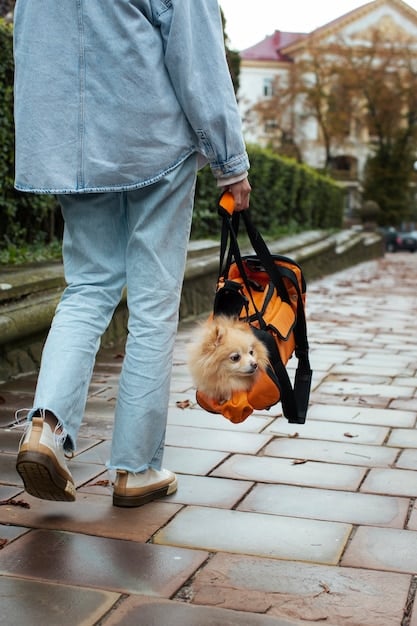
Avoiding these common mistakes will help you create a more effective and positive training experience. Adjust your approach as needed, and celebrate small victories along the way.
Addressing Specific Challenges
Every dog is an individual, and some may present unique challenges when it comes to loose-leash walking. Addressing these specific issues requires a tailored approach. Let’s delve into some common challenges and how to overcome them, in order to train your dog to walk nicely on a leash.
Being prepared to adapt your training methods to suit your dog’s individual needs is crucial. Each dog may need a unique mix of stimuli and positive reinforcement.
High-Energy Dogs
High-energy dogs may require more frequent and intense exercise before training sessions to help them release pent-up energy.
Reactive Dogs
Reactive dogs may need to start training in a quiet, controlled environment with minimal distractions. Gradually introduce them to more stimulating environments as they progress.
- Anxious Dogs: Anxious dogs may benefit from confidence-building exercises and a calm, reassuring presence during walks.
- Puppies: Puppies have short attention spans. Keep training sessions brief and focus on positive reinforcement.
- Older Dogs: Older dogs may have physical limitations. Adjust your training approach to accommodate their needs, and consult with a veterinarian if necessary.
Understanding the root of the behavior and building clear communication can greatly improve the effectiveness of your training. Positive reinforcement is a powerful tool for helping anxious dogs feel more secure.
By identifying and addressing specific challenges, you can tailor your training approach to meet your dog’s individual needs. This personalized approach can lead to greater success in achieving loose-leash walking.
Maintaining Consistent Progress
Achieving loose-leash walking is a great accomplishment, but it’s important to maintain consistent progress over time. Regular reinforcement and ongoing practice are key to preventing regressions. Let’s explore how to keep your dog walking nicely on a leash long-term.
Consistency ensures that your dog continues to associate good behavior with positive outcomes. This helps sustain the training gains you’ve achieved.
Regular Practice
Continue practicing loose-leash walking regularly, even after your dog has mastered the basics. This reinforces the training and keeps the behavior fresh in their mind.
Varying Environments
Expose your dog to different walking environments to generalize their training. Practice in parks, on sidewalks, and in other areas where they may encounter distractions.
- Consistent Commands: Continue using clear, concise commands to guide your dog during walks.
- Positive Reinforcement: Keep rewarding good behavior with praise and treats.
- Addressing Setbacks: If your dog starts to pull again, revisit the training techniques and reinforce the basics.
A well-trained dog is a happier and more relaxed dog. Consistent practice and consistent verbal cues helps in ensuring that the benefits of loose-leash walking endures.
Maintaining consistent progress requires ongoing effort and attention. By continuing to practice, reinforce, and adapt, you can ensure that your dog remains a well-behaved walking companion for years to come.
| Key Point | Brief Description |
|---|---|
| 🐾 Start Early | Begin training indoors to familiarize your dog with the leash. |
| 🛑 Stop & Wait | When your dog pulls, stop immediately until the leash loosens. |
| Direction Changes | Change direction to keep your dog focused on you during walks. |
| Treat Rewards | Reward your dog for walking with a loose leash to reinforce positive behavior. |
Frequently Asked Questions (FAQs)
▼
The training time varies depending on your dog’s breed, age, and temperament. Some dogs may learn in a few weeks, while others may take several months. Consistency and patience are key.
▼
Start training in a quiet environment with minimal distractions. Gradually expose your dog to more stimulating environments as they progress. Consult a professional trainer if needed.
▼
Yes, a clicker can be a useful tool for marking the desired behavior. Pair the click with a treat to create a positive association. Use the clicker right as your dog is performing the appropriate behavior, rewarding immediately after.
▼
Use small, soft treats that your dog loves. High-value treats, such as small pieces of cooked chicken or cheese, can be particularly effective for capturing their attention.
▼
Aim for short, frequent training sessions. 10-15 minutes sessions, once or twice a day, are more effective than one long session. Keep the sessions upbeat and positive.
Conclusion
Teaching your dog to walk nicely on a leash is a rewarding journey that enhances both your and your dog’s quality of life. By understanding the importance of loose-leash walking, using the right equipment, and applying consistent training techniques, you can transform your walks into enjoyable experiences. Remember to address specific challenges, maintain consistent progress, and celebrate every success along the way, and remember the keyword, train your dog to walk nicely on a leash.

